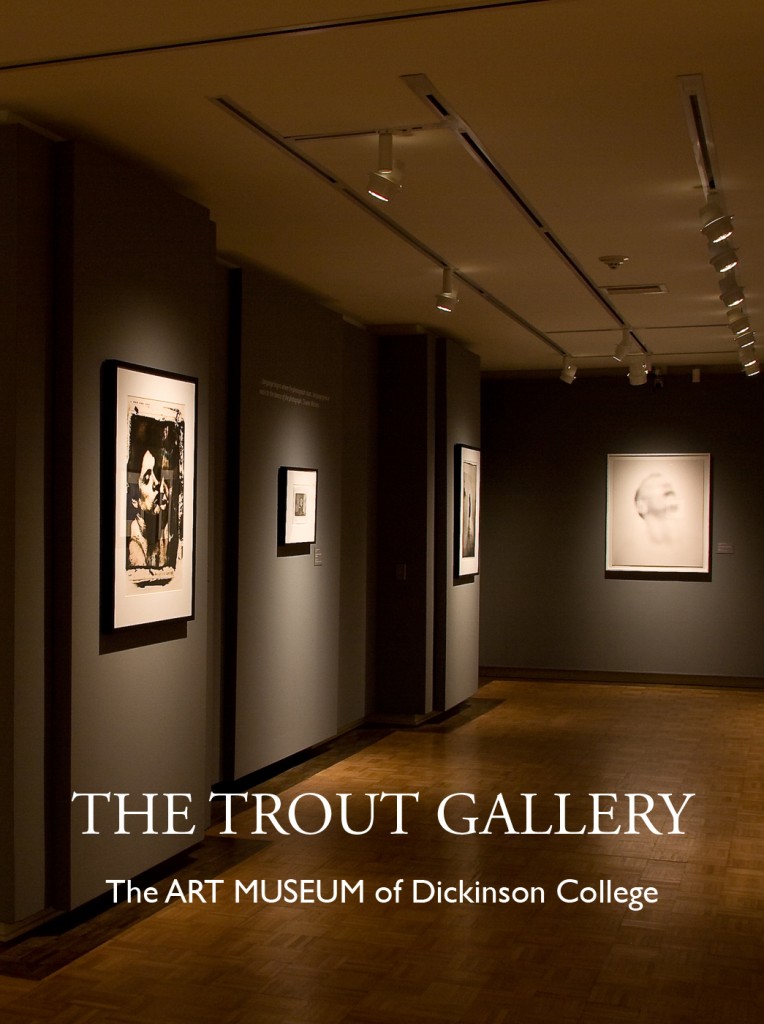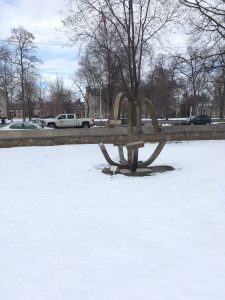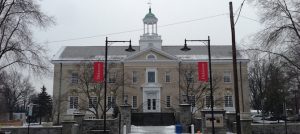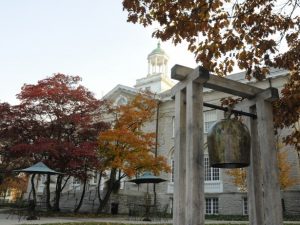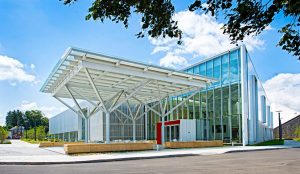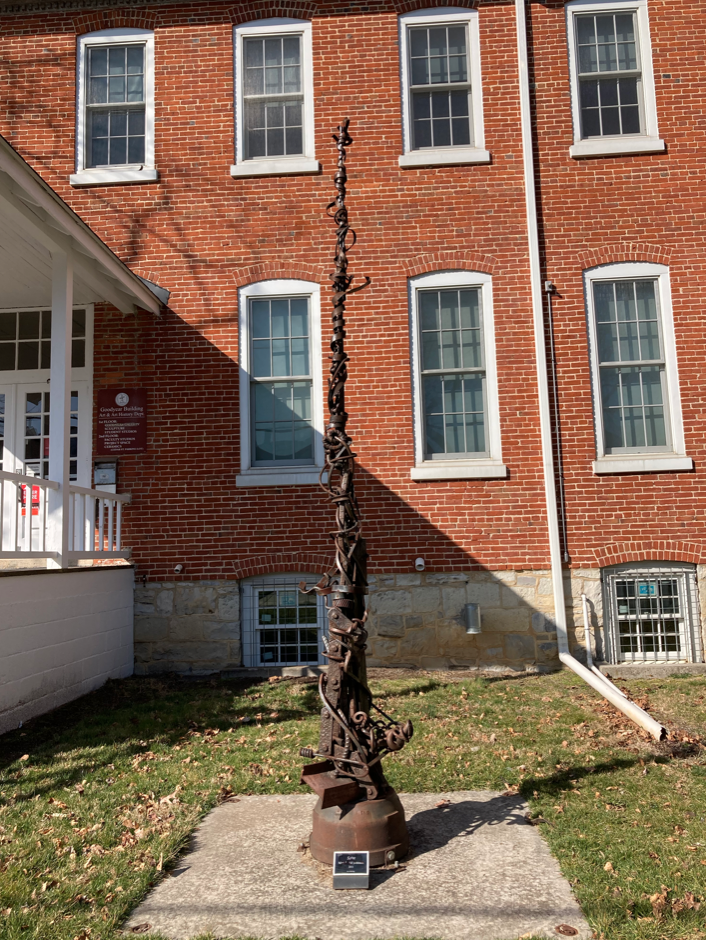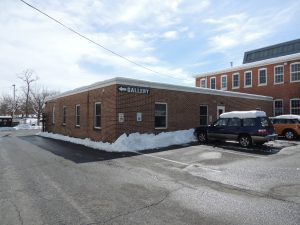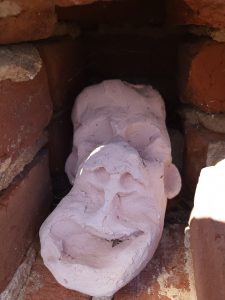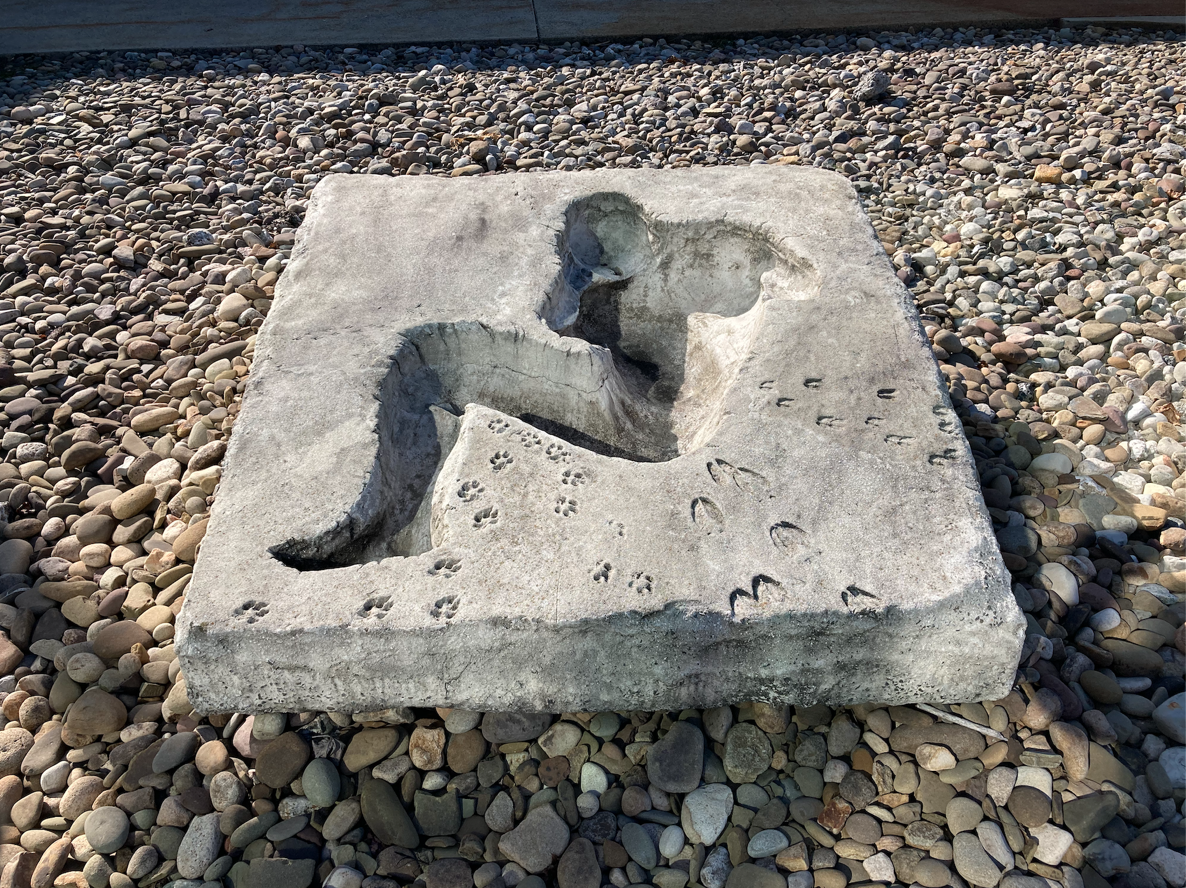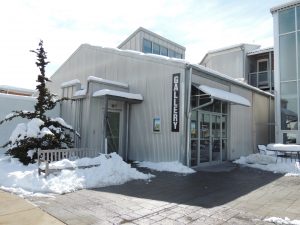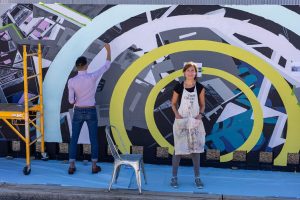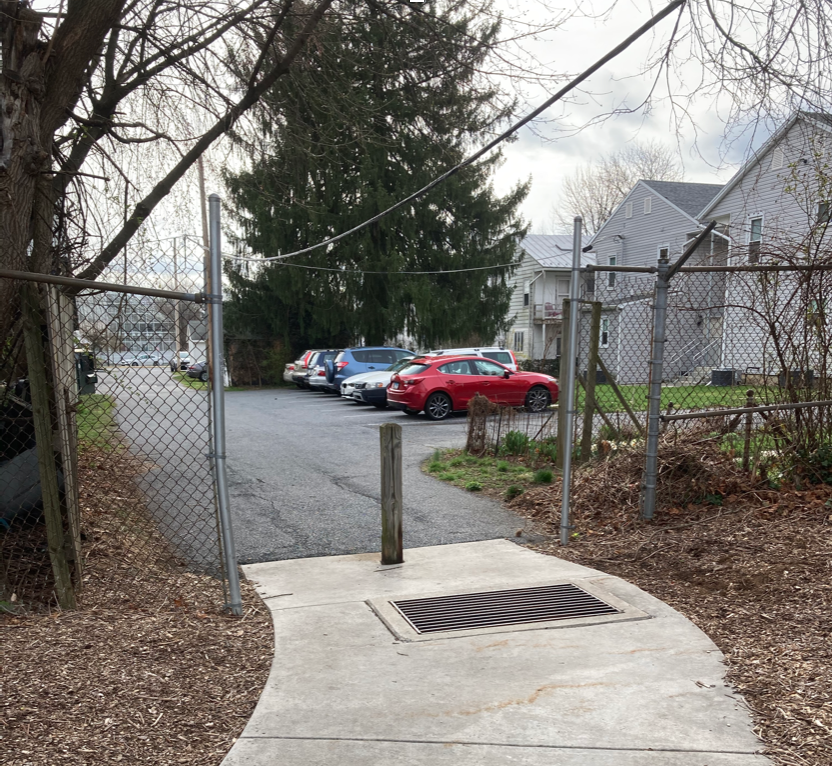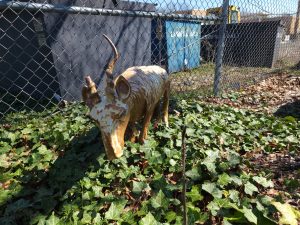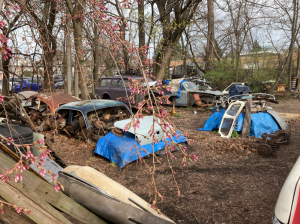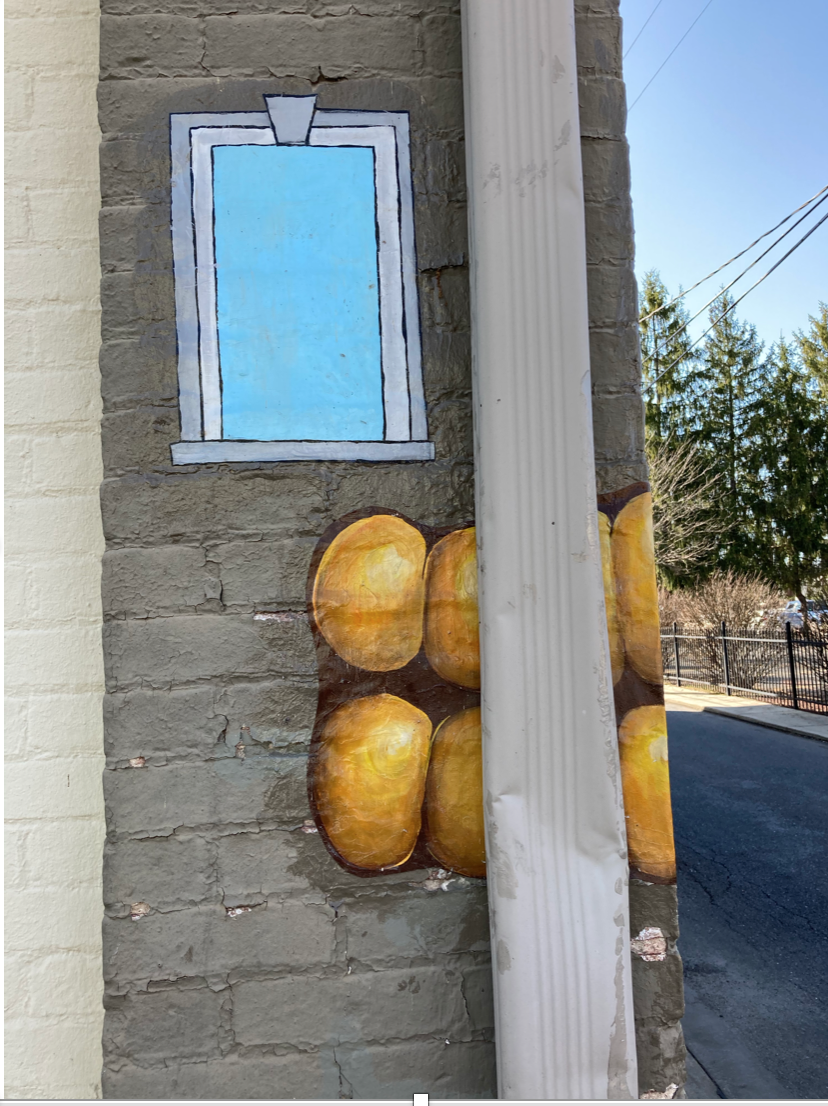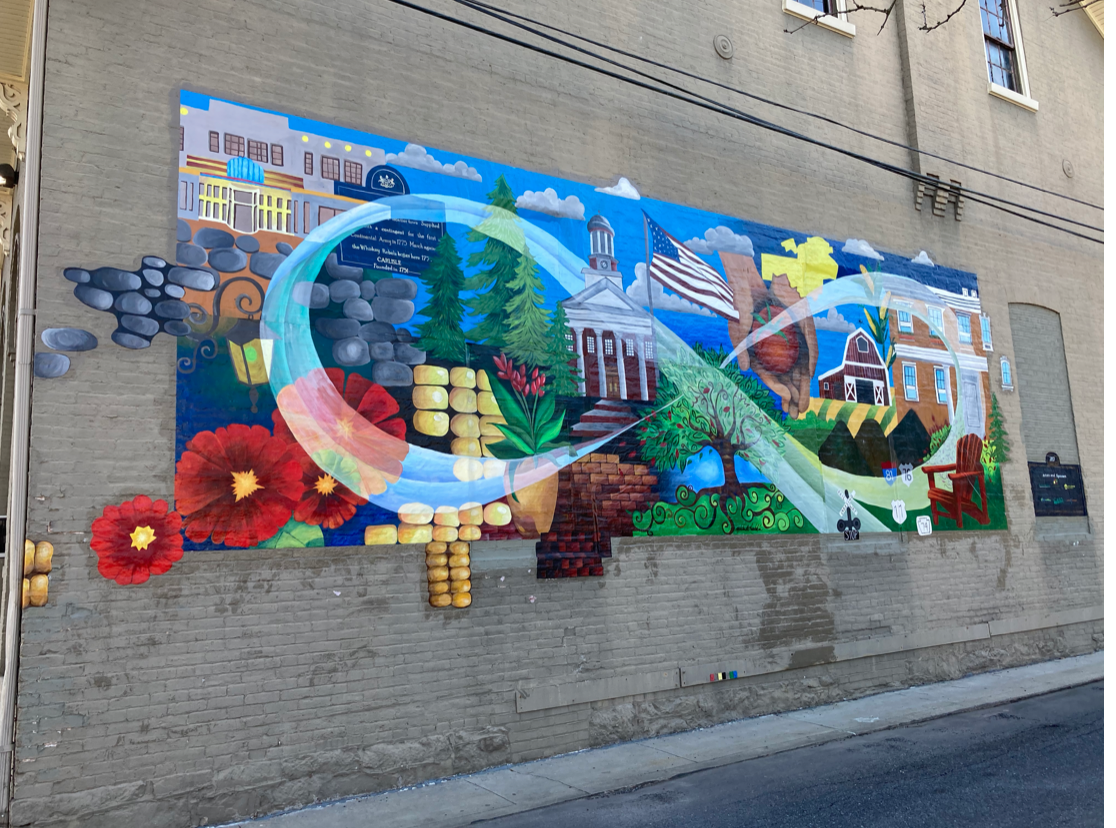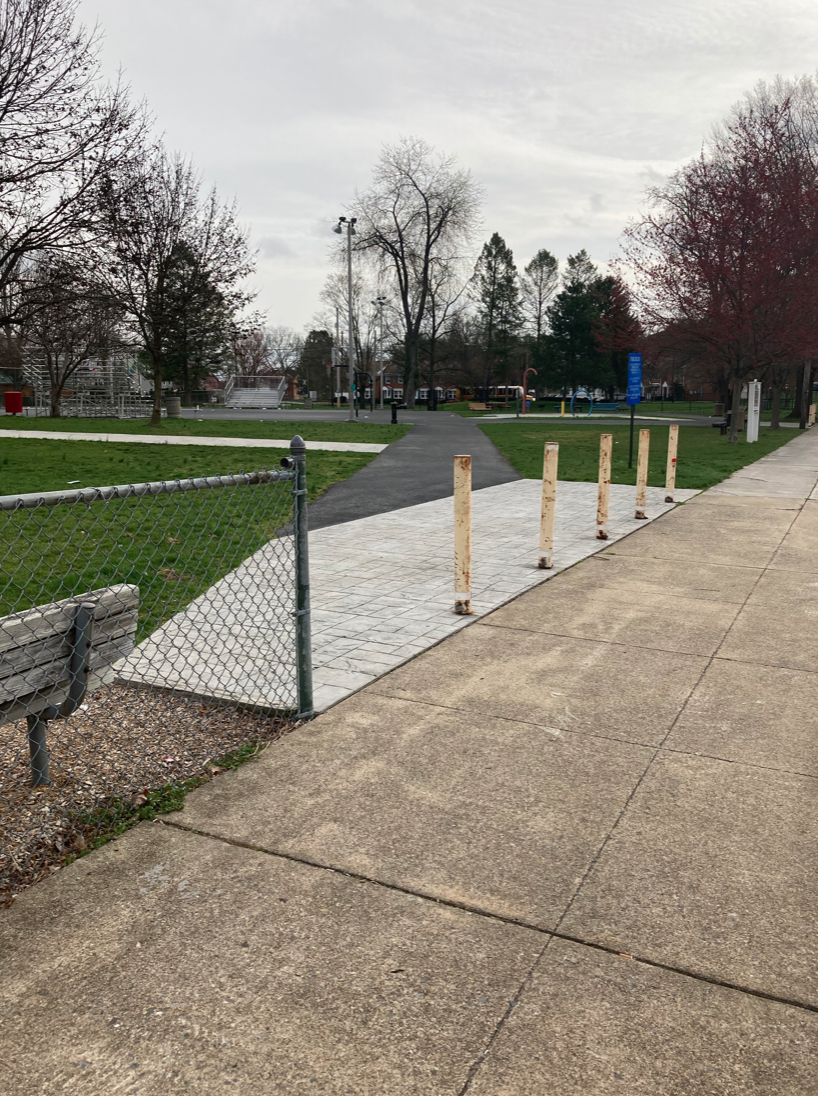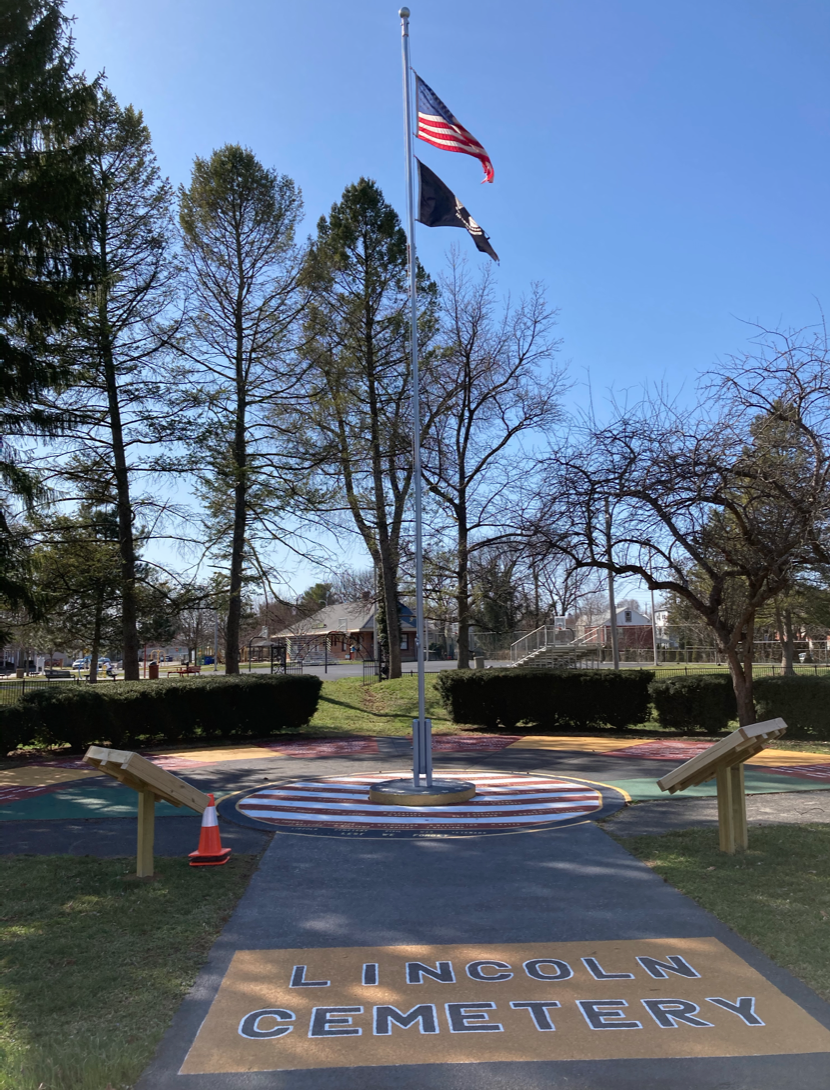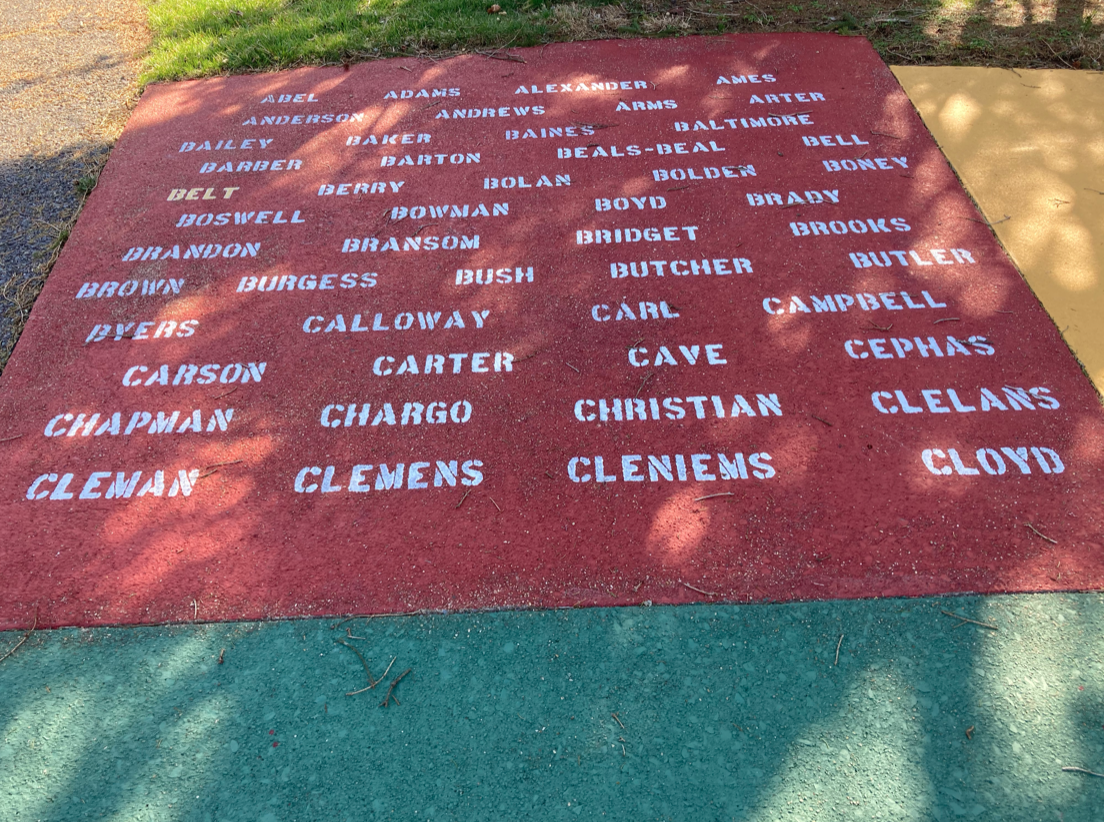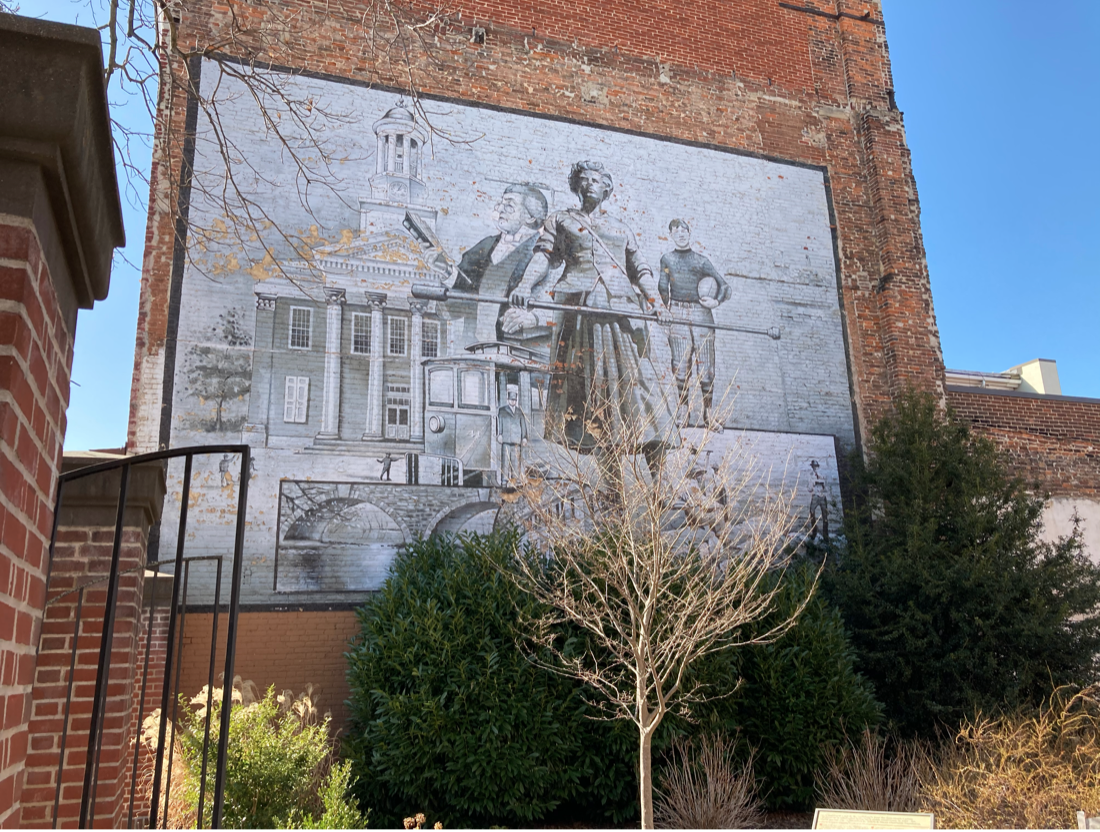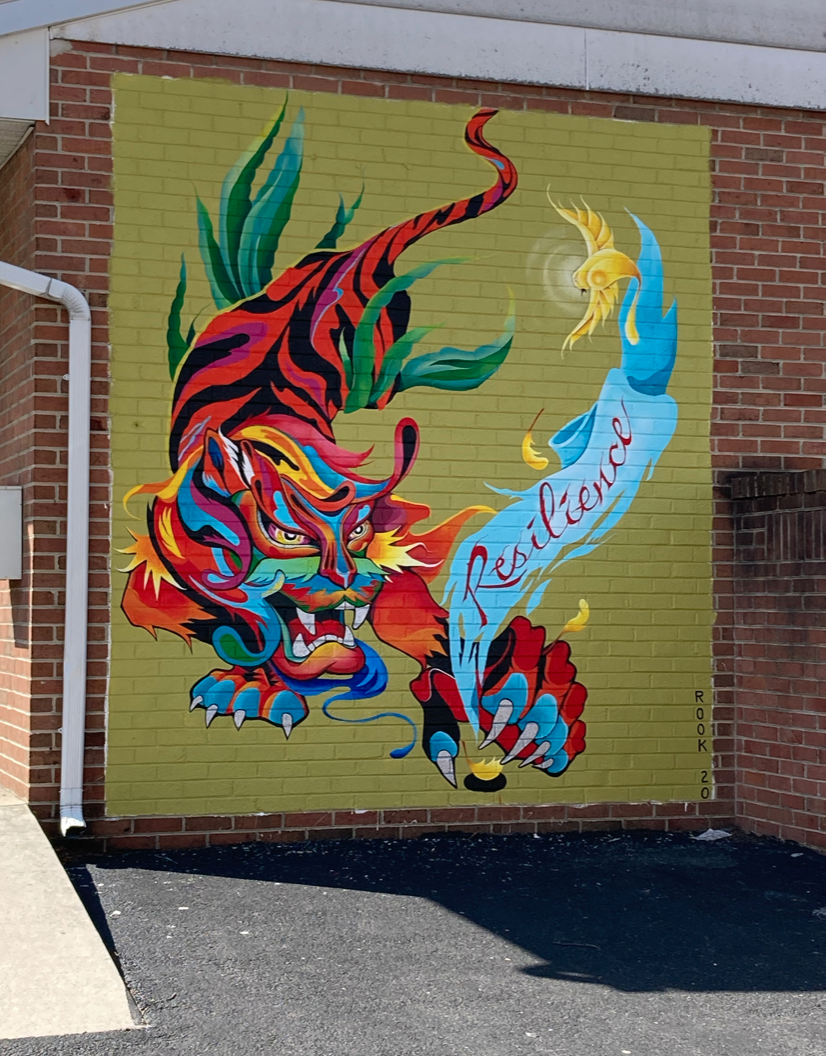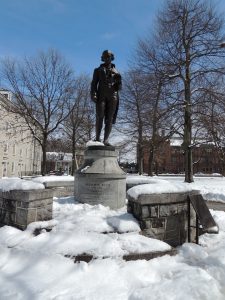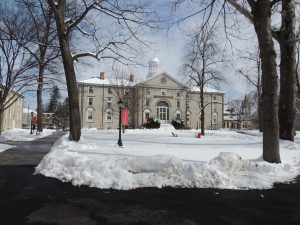Artwalk
Spring into Fitness Challenge
Art Walk!
Dickinson College
Welcome to Dickinson’s Art Walk sponsored by The Trout Gallery. This is your chance to learn about art on Dickinson’s campus and around town and get 4,843 steps. The route makes a large figure-eight, beginning and ending with bronze outdoor sculptures on campus. If you’d like to split up the walk, simply follow one loop of the figure-eight at a time. To follow the route, simply click on the stops below. Along the way, we provide interesting background information (culled from campus and local news articles, videos, websites, and interviews) about what you’re seeing.
Enjoy your walk!
1.
Begin your walk on the plaza in front of The Weiss Center for the Arts. On the East side of the lawn you will see a large geometric-looking round shape. This bronze, eight-foot sculpture cuts an eye-catching figure on a campus that traditionally draws aesthetic interest from its stately architecture, lush flora and canopies of trees. The artist, Patrick Strzelec, titled the work “Negotiation,” and explains that it’s a representation of the dialogues we engage in—internal and external, trivial and profound—throughout each day. But he’s quick to note that the sculpture, commissioned by former Dickinson president William Durden ’71, and his wife Elke, invites varied interpretations and sparks conversation, inspiration and debate.
Turn now to face the facade of the Weiss Center for the Arts.
2.
The Trout Gallery was created in 1983 as part of the transformation of the college’s old field house into the Emil R. Weiss Center for the Arts. Look at the façade of the Weiss Center and compare Weiss to Old West, just across the street. Notice any similarities? Weiss was patterned after Benjamin Latrobe’s famous design of Old West. Funding for the new art museum was provided by Ruth Trout ’36, and her sister Helen, who named it in honor of their parents Brook and Mary.
With over 10,000 works of art in its permanent collection, The Trout Gallery features the most extensive art collection in the greater Carlisle area. It seeks to inspire creativity and to support the study and experience of the visual arts through direct contact with works in the Gallery’s collections and exhibitions. The Gallery is free and during COVID open to the Dickinson campus community Monday-Saturday 10AM-4PM.
To see what’s on view right now at The Trout, click HERE.
Turn around, and to your left you will see a bell-shaped sculpture.
3.
On the west side of Weiss plaza is another work of outdoor sculpture in the form of a bell. The Toshiko Takaezu bronze bell Autumn II was acquired to mark the entrance to the Emil R. Weiss Center for the Arts. The bell is not only a fitting work for visual artists and musicians, it also makes reference to the original bell that once stood in the cupola of Old West, which marked the hours of the academic day throughout the nineteenth century. Toshiko Takaezu, a master ceramicist from Hawaii, designed the bell according to Japanese models. Consequently, it lacks an internal clapper. To ring the instrument, one must strike its exterior with a large wooden mallet. The bell was cast at the Johnston Atelier.
Proceed now to Britton Plaza located adjacent to the Holland Union Building (HUB).
4. 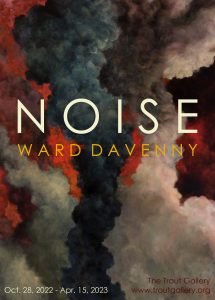
The Trout Gallery is free and open to the public Monday-Saturday from 10AM-4PM. Exhibitions currently on view are Bronze and Noise: Ward Davenny. Bronze features works of figural bronze sculpture from the permanent collection spanning four continents and eleven decades. Noise brings together prints, photographs, drawings and paintings by Professor Emeritus of Art, Ward Davenny. His brother-in-law composed a musical score to accompany the exhibition. To listen to the score while walking through the show, go to YOUTUBE.
5.
Directly in front of you looms the Kline Center. Since its completion in 2014, the Kline Center expansion has garnered more than a couple of accolades. The structure has graced the cover of Athletic Business magazine’s 29th-annual “Architectural Showcase” issue. The issue highlighted 61 athletics, fitness and recreation facilities from across the country, and the Kline’s presence on the cover is a testament to the project’s striking, modern design.
Architect and Dickinson Trustee Sylvia Smith ‘73 has described how: With its open, light-filled design, energy-efficient systems and indoor-outdoor social areas, the Kline expansion blurs the lines between the natural and the manmade, and its visual extension of Dickinson Walk—a pathway through the heart of the campus—creates a clear straight line that connects the Kline Center to the rest of the campus.
When you reach the Kline Center, turn right onto Cherry Street, and then make your first left onto Louther Street, proceeding to The Goodyear Building.
6.
Spire was created by sculptor Matt Evald Johnson from formed and welded steel in 2011. It was installed in front of the Goodyear Gallery in 2012 as a three-year loan. In 2015, the sculpture was purchased outright and today it stands sentinel at the entrance to The Goodyear Gallery, home of many Studio Art spaces, including the ceramics, digital media, and sculpture studios, the Goodyear Gallery, faculty studio spaces and Dickinson student studio spaces.
Continue along Louther Street to the corner, and turn right onto Cedar Street. Proceed alongside the Goodyear building until you see the building below, which houses the Dickinson ceramics studio.
7.
Curious what it’s like inside the ceramics studio? Check out the video below to find out.
Follow the driveway to the left of the Ceramics Studio into the back parking lot. Immediately to your right as you enter the parking lot look closely at the back wall of the ceramics studio.
8.
Can you find this squishy face? It is embedded in the outside wall of the ceramics studio along with many other miniature friends. To learn the story of this wall, we turned to Brooke Wiley, longtime Studio Art Technician at Dickinson.
It turns out, Brooke started putting stuff in the cracks a long time ago. Then people in the studio started too, and visiting artists. Stuff showed up/ disappeared/ moved/ got cemented in/ broke purposely/ etc. Eventually, everyone started calling it the Wall Gallery, and thus it has remained.
Which Wall Gallery character is your favorite?
Continue along The Gallery Wall into the open courtyard that houses the entrance to The Goodyear Gallery.
9.
In the center of the open courtyard you will find a large installation featuring the work of Shippensburg University Professor of Art, Steve Dolbin. Titled, Perception of Absence, the work includes a hollow reinforced concrete slab carved in relief to reveal a seated figure. A variety of animal footprints imprinted in the concrete seem to converge upon the figure, only known through the impression left behind. Situated within a sunken bed of rocks and pebbles, Perception of Absence, provides a meditative site for quiet contemplation.
Directly opposite Dolbin’s sculpture, sits the entrance to The Goodyear Gallery.
10.
The Goodyear Gallery serves the department of art & art history and the college community, by showcasing the work of contemporary and emerging artists, and studio art senior seminar during an annual exhibition that takes place each fall. Gallery programming is focused on providing support to classes in the department and affording students the opportunity to learn from working artists by installing shows and maintaining and curating the gallery space. Most exhibitions have opening receptions that often include artist talks and are open to the general public. Peek inside the windows for a glimpse of the current exhibition.
Continue along the side of the Goodyear Gallery until you see the mural below.
11.
As you exit the Goodyear Gallery take a moment to peruse the large colorful mural that spans the adjacent exterior wall of the building. This is called The Goodyear Project Wall, and is dedicated to large-scale public art projects that are collaborative in nature. For the past five years, artists have been coming to Dickinson to help studio art majors and members of the Arts Collective paint a mural on the wall behind the Goodyear building. Each visiting artist works with around a dozen students to design the mural, prepare and paint the wall and record the process.
North Carolina-based artist Joelle Dietrick grew up 25 miles from Three Mile Island, the power plant that is the site of the most large-scale U.S. nuclear disaster in history. She will returned to the area to paint this mural on the Dickinson College Goodyear Project Wall from Sept. 28 – Oct. 3, 2021.
The mural includes an extinct plant from Pennsylvania (Elodea schweinitzii Casp. / Schweinitz’s waterweed) and a net-positive house in the same time zone (Chapel Hill, North Carolina) by Arielle Condoret Schecher. The concentric circles in the composition reference to Dietrick’s young daughter’s reaction to her three-country Fulbright to Germany, Chile and Hong Kong: never a great sleeper and slowly processing the idea of time zones, her daughter asked “if I were to travel at the same rate as the sun, would I ever need to sleep?”
The question stuck with Dietrick, evoking thoughts about our innate curiosity about the world, the internet’s escalation of that wonder, and its cultivation of excessive longing for other places.
Now, follow the sidewalk along the mural (running along the back of the Goodyear building) until you see the gate opening pictured below.
Walk through the gate, and look immediately to your left as you enter the parking lot beyond.
12.
Sometimes you can find art where you least expect it! The Volvo graveyard behind this fence gives Carhenge (https://carhenge.com/) a run for its money. Word on the street is that the owner repairs Volvos.
Continue through the parking lot until you arrive back at Cherry Street. Make a right and then an immediate left onto Louther Street. If you’d like to complete just half the figure-eight (about 1 mile), you can return to the Weiss Plaza.
If you’d like to complete the whole walk, continue along Louther until you reach St. Paul’s Church, make a left onto West Street along the left side of the street. Just before you reach Locust Street, you will see a clue to our next stop on the side of a building:
Round the corner to see the full mural.
13.
This mural is the result of a collaborative project between Color Carlisle and the Carlisle Area School District. Color Carlisle: Mural Project is an unincorporated group formed to address needs of focused attention on safety and building maintenance/upkeep as well as providing targeted measures for increased safety and awareness in various neighborhoods in Carlisle, PA. The goal, through a community art initiative, is to create sustainable living spaces by updating strategic locations with public art.Artist Ophelia Chambliss was the artist in residence for the project, working with portfolio-level art students at Carlisle high school and supervising the installation.
The project began as a checklist of the places and objects that Carlisle High School students considered important to the town’s past, present and future. That checklist became images. Those images were revealed to the public in October of 2018.
The resulting mural features images of landmarks like the Carlisle Theatre and the Old Courthouse, as well as images symbolic of the area’s agricultural heritage and the iconic red Adirondack chairs at Dickinson College.Continue north along West Street until you reach West Penn Street. Take a right on Penn and walking through Memorial Park along the path shown below:
Follow the path until you reach the entrance to Lincoln Cemetery. Take the left branch of the path, which will lead you to a new memorial for the soldiers buried in this cemetery.
14.
Lincoln cemetery served as the segregated cemetery in Carlisle for at least a century. The names within the painted flag recognize the fifty-two Civil War veterans buried here. Additional names painted around the flag in a fan shape are the family names of those buried here. The addition of these names and the painted sections of the plaza represent a recent initiative to encourage community recognition of those buried here, and to stimulate dialogue about how to memorialize them as vital contributors to Carlisle history.
Exit Lincoln Cemetery via Penn Street and proceed east towards Hanover Street. Turn right on Hanover Street, and when you reach Sadler Health Center at the corner of West Louther and Hanover, take a peek around the corner to look at the side of the building.
15.
Created by students at Carlisle Arts Learning Center, Wings of Hope addresses mental illness and the growing number of teens struggling with depression, anxiety and suicidal thoughts. Students working on the project wanted to make the community more aware of mental illness, which is often stigmatized, under-diagnosed, and under-treated. They chose the butterfly as a symbol of the transformation that can occur when a community provides access to resources that support those suffering from mental illness.
Turn back to Hanover Street and continue to High Street.
16.
Make a right on High Street and continue until just past the Cumberland County Historical Society shop. On your right, you will see the entrance to a small courtyard featuring a large mural.
This large black-and-white mural was commissioned in 2001 for the 250th anniversary of the founding of Carlisle and depicts people, places and objects symbolic of borough and Cumberland County history.
Artist Wayne Fettro of Elizabethtown was hired by the Cumberland County Historical Society and the Downtown Carlisle Association to paint the mural onto the brick wall. He started the project in late May 2001 and finished a week or so later. Images used in the composite depict the Old County Courthouse, Molly Pitcher, Jim Thorpe, the LeTort Spring Run, the Two Mile House and the view from Flat Rock at Doubling Gap.
These images are arranged into a collage that also includes a trolley and a man wearing a mortar board. The trolley is symbolic of Cumberland County’s role as a transportation hub while the man represents a history of education. Carlisle Borough is home to Dickinson College, Dickinson School of Law, the U.S. Army War College at Carlisle Barracks and Pennsylvania’s first public high school.
Exit the courtyard through the adjacent parking lot and turn left into the Vale-Himes Park, adjacent to the Cumberland County Historical Society. As you walk through the small park, pay attention to the lines on the ground. They represent landmark lines in Cumberland County.
Exit the park, and turn left into North Pitt Street. Head Towards High Street. Directly across the street, on the side of a building you will see a brightly-colored mural.
17.
The mural Resilience came about after artist Aron Rook, received a grant through the Community Partners Program to paint murals throughout Carlisle. Since the pandemic and sheltering in place orders, she sought to offer a mural that helps lift morale, hence the tiger in tribute to the “Resilience” that exists within each of us in the face of life’s challenges.
“The Carlisle community is my hometown and has been an incredible force of support over the years,” she said. “This project is an endeavor to give back and support my community as it has supported me over the years.” Rook references a study by the Center for Community and Economic Development, in central Arkansas, citing that “murals revitalize communities and aid in economic development.”
To those ends, Rook said, “I like playing my part in helping Carlisle prosper.”Continue along Pitt Street to High Street, cross the street so that you are on the south side of High Street (side with Clothesvine). Continue along High Street until you come to the windows of the Century Link Building.
18.
The windows on the Century Link building at 120 W. High Street are frequently filled with artworks made by students in Carlisle Arts Learning Center programs. The theme, design, and works themselves often represent issues seen as important to these students or to contemporary society.
These images were made by students in CALC’s program ArtWorks! This after-school program is for middle school students and promotes self-esteem and giving back to the community through the arts. For these windows, students created the 36 original images of flowers and text that you see here ! Each flower represents a nation accompanied by the phrase “Welcome” in the corresponding language.
Continue along High Street until you reach West Street. Cross to the other side of the street and enter the Dickinson College campus. Proceed to the statue of Benjamin Rush.
19.
The statue of Benjamin Rush strategically stands in front of Old West, the original college building which he helped fund and establish. The casting is a modern version made from Roland Hinton Perry’s original bronze, which stands on the grounds of the Army Medical Museum and Library (formerly the Naval Hospital) in Washington, D.C. the casting demonstrates the lingering Beaux-Arts style popular at the end of the nineteenth and early twentieth century. This version was cast from molds taken from Perry’s original by the Johnston Atelier.
Turn now to the building the statue faces, Old West.
20.
Old West was designed by Benjamin Latrobe, architect of the United States Capitol. As the college grew in population and prominence, college leaders decided to construct a new “edifice” to serve as the center of campus-and to allow Dickinson to move out of the old grammar school that had been its home since its founding. Called “New College,” the building was constructed slowly, over a period of four years. In 1803, as the college prepared to settle into New College, a blustery snowstorm pushed through the Cumberland Valley, stirring some smoldering ashes in the building’s basement. The ashes began to flame, and before long the building had burned to the ground.
Despite the initial despair (Col. John Montgomery, a U.S. Congressman and longtime Dickinson trustee, wrote to inform Rush of the fire, lamenting that all of their hopes “were Blasted in a few minutes”), hints of good fortune soon began to ameliorate the situation. For instance, Benjamin Latrobe, architect of the U.S. Capitol, offered to draw up plans for a new college hall. And private donations from individuals such as Thomas Jefferson and James Madison ensured the reconstruction of Dickinson College in swift fashion. Though Charles Nisbet would not live to see its completion, West College–or Old West, as it’s commonly called–hosted its first classes in November 1805.
Congratulations! You just completed at least 4,843 steps and hopefully have a greater appreciation for the rich visual culture of Dickinson College and downtown Carlisle.
